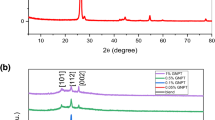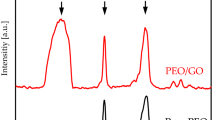Abstract
The incorporation of nanoscale organic or inorganic components into polymer blend is a key strategy for optimizing the efficiency of material features such as structural, physical, chemical, optical, electrical, and thermal characteristics. Polymer nanocomposites are a new type of material created with nanostructure additives such as metals, metal oxides, and so on. Transition metal oxides such as graphene oxide have been extensively studied for applications including electrical, optical, and mechanical properties over the last several decades. Samples of polyvinyl alcohol and polyethylene oxide (PVA/PEO) loaded with different quantities of graphene oxide nanosheets (GO) were created using the casting technique. Various techniques were used to characterize the produced samples, including XRD, FTIR, SEM, UV/Vis, DSC, TGA, and dielectric characteristics. XRD verified the semicrystalline structure of the PVA/PEO blend, with crystallinity decreasing as the GO nanosheets percentage increased. With the decreasing frequency and varied concentrations of GO nanosheets, the FTIR absorption spectra demonstrate a shift in peak locations and intensity fluctuations. The crystalline regions have a roughly spherical shape, as shown in SEM pictures. The optical band gap (direct and indirect) is calculated using UV–Vis spectra, which decreases with increasing dopant concentration. The single glass transition temperature (Tg) is seen in the DSC analysis, indicating that PVA and PEO are miscible. The inclusion of filler changes the amorphous phase, resulting in a variation in melting temperature (Tm). The dynamic ion activity of the produced samples was determined using the frequency-dependent composite films (AC conductivity). At various concentrations and room temperatures (RT), the dielectric constant (ε′), dielectric loss (ε″), and tanδ versus frequency graphs were also obtained. The ionic conductivity of composite PVA/PEO/GO samples increased at room temperature with the addition of graphene oxide reaching a maximum of 10–9 S/c. These results are projected to have an important effect on different applications, especially energy storage, polymer solar cells, and polymer organic semiconductor.













Similar content being viewed by others
Data availability
The data that support the findings of this study are available on request from the corresponding author. The data are not publicly available due to privacy or ethical restrictions.
References
H. Zidan, M. Abu-Elnader, Structural and optical properties of pure PMMA and metal chloride-doped PMMA films. Physica B 355(1–4), 308–317 (2005)
H. Ragab, Spectroscopic investigations and electrical properties of PVA/PVP blend filled with different concentrations of nickel chloride. Physica B 406(20), 3759–3767 (2011)
H. Ragab, Studies on the thermal and electrical properties of polyethylene oxide/polyvinyl alcohol blend by incorporating of cesium chloride. Result. Phys. 7, 2057–2065 (2017)
V. Suvith, V. Devu, D. Philip, Tannic acid mediated synthesis of nanostructured NiO and SnO2 for catalytic degradation of methylene blue. Opt. Quant. Electron. 52(1), 1–17 (2020)
H. Zidan et al., Photodegradation of methylene blue with PVA/PVP blend under UV light irradiation. Spectrochim. Acta Part A Mol. Biomol. Spectrosc. 199, 220–227 (2018)
H. Zidan et al., Structural and electrical properties of PVA/PVP blend doped with methylene blue dye. Int. J. Electrochem. Sci 11, 9041–9056 (2016)
R. Hajian et al., Properties and applications of functionalized Graphene oxide. Mater. Matters 14, 1–15 (2019)
A. Aykan et al., A comparative study of CO catalytic oxidation on the single vacancy and di-vacancy graphene supported single-atom iridium catalysts: A DFT analysis. Surfaces and Interfaces 25, 101293 (2021)
A. Akça et al., Theoretical Insights into the NH3 Decomposition Mechanism on the Cu-and Pt-Embedded Graphene Surfaces: A DFT Approach. ECS Journal of Solid State Science and Technology 10(10), 101008 (2021)
O. Karaman et al., Electrochemical cardiac troponin I immunosensor based on nitrogen and boron-doped graphene quantum dots electrode platform and Ce-doped SnO2/SnS2 signal amplification. Materials Today Chemistry 23, 100666 (2022)
C. Karaman et al., Electrochemical neuron-specific enolase (NSE) immunosensor based on CoFe2O4@ Ag nanocomposite and AuNPs@ MoS2/rGO. Anal. Chim. Acta 1200, 339609 (2022)
C. Karaman et al., A novel electrochemical aflatoxin B1 immunosensor based on gold nanoparticle-decorated porous graphene nanoribbon and Ag nanocube-incorporated MoS 2 nanosheets. New J. Chem. 45(25), 11222–11233 (2021)
M. Ghaedi et al., Application of activated carbon as adsorbents for efficient removal of methylene blue: Kinetics and equilibrium study. J. Ind. Eng. Chem. 20(4), 2317–2324 (2014)
M. Farea et al., Effect of cesium bromide on the structural, optical, thermal and electrical properties of polyvinyl alcohol and polyethylene oxide. J. Market. Res. 9(2), 1530–1538 (2020)
A. Abdelghany, M. Farea, A. Oraby, Structural, optical, and electrical reinforcement of gamma-irradiated PEO/SA/Au NPs nanocomposite. J. Mater. Sci.: Mater. Electron. 32(5), 6538–6549 (2021)
M. Meikhail et al., Spectroscopic studies of PVA/PEO hydrogel filled with cesium chloride. Res. J. Pharm. Biol. Chem. Sci 5, 976–983 (2014)
M. Mohammed et al., Synthesis, optical properties, and impedance spectroscopy of Na2TeO3 doped polyvinyl alcohol as novel polymeric electrolyte films. Opt. Quant. Electron. 53(6), 1–25 (2021)
L. Fan et al., Preparation and characterization of quaternary ammonium chitosan hydrogel with significant antibacterial activity. Int. J. Biol. Macromol. 79, 830–836 (2015)
M. Farea, A. Abdelghany, A. Oraby, Optical and dielectric characteristics of polyethylene oxide/sodium alginate-modified gold nanocomposites. RSC Adv. 10(62), 37621–37630 (2020)
K.K. Kumar et al., Investigations on the effect of complexation of NaF salt with polymer blend (PEO/PVP) electrolytes on ionic conductivity and optical energy band gaps. Physica B 406(9), 1706–1712 (2011)
E. Abdelrazek, I. Elashmawi, Characterization and physical properties of CoCl2 filled polyethyl-methacrylate films. Polym. Compos. 29(9), 1036–1043 (2008)
M. Morsi et al., Structural, optical, thermal, and dielectric properties of polyethylene oxide/carboxymethyl cellulose blend filled with barium titanate. J. Phys. Chem. Solids 125, 103–114 (2019)
A. Al-Muntaser et al., Structural and optical characterization of thermally evaporated nanocrystalline 5, 10, 15, 20-tetraphenyl-21H, 23H-porphine manganese(III) chloride thin films. Optik 167, 204–217 (2018)
E. Abdelrazek, A. Abdelghany, A. Aldhabi, Influence of manganese chloride filler on optical and structural properties of PVA/PVP films. Mater. Sci. An Indian J. 10, 1–11 (2013)
A. Abdelghany, H. ElBatal, L. Marei, Optical and shielding behavior studies of vanadium-doped lead borate glasses. Radiat. Eff. Defects Solids 167(1), 49–58 (2012)
S. Mallakpour, S. Rashidimoghadam, Application of ultrasonic irradiation as a benign method for production of glycerol plasticized-starch/ascorbic acid functionalized MWCNTs nanocomposites: investigation of methylene blue adsorption and electrical properties. Ultrason. Sonochem. 40, 419–432 (2018)
W.C. Lai, W.B. Liau, Study of the miscibility and crystallization behavior of poly (ethylene oxide)/poly (vinyl alcohol) blends. J. Appl. Polym. Sci. 92(3), 1562–1568 (2004)
O.W. Guirguis, M.T. Moselhey, Thermal and structural studies of poly (vinyl alcohol) and hydroxypropyl cellulose blends (2011)
E.M. Abdelrazek et al., Structural, optical, thermal and electrical studies on PVA/PVP blends filled with lithium bromide. Curr. Appl. Phys. 10(2), 607–613 (2010)
S. Barrau et al., DC and AC conductivity of carbon nanotubes− polyepoxy composites. Macromolecules 36(14), 5187–5194 (2003)
V. Krstic et al., Electrical transport in single-walled carbon nanotube bundles embedded in Langmuir-Blodgett monolayers. Synth. Met. 110(3), 245–249 (2000)
R. Sengwa, S. Choudhary, Investigation of correlation between dielectric parameters and nanostructures in aqueous solution grown poly (vinyl alcohol)-montmorillonite clay nanocomposites by dielectric relaxation spectroscopy. eXPRESS Polym Lett. 4(9) (2010)
A. Abdelghany, A. Oraby, M. Farea, Influence of green synthesized gold nanoparticles on the structural, optical, electrical and dielectric properties of (PVP/SA) blend. Physica B 560, 162–173 (2019)
V.S. Yadav, et al., Frequency and temperature dependence of dielectric properties of pure poly vinylidene fluoride (PVDF) thin films. In AIP Conference Proceedings. 2010. American Institute of Physics.
Funding
The authors have not disclosed any funding.
Author information
Authors and Affiliations
Contributions
HMR: Investigation, Writing—Review and Editing, Methodology, Formal analysis, Conceptualization. There are no other authors.
Corresponding author
Ethics declarations
Conflict of interest
The authors declare that they have no conflict of interest.
Additional information
Publisher's Note
Springer Nature remains neutral with regard to jurisdictional claims in published maps and institutional affiliations.
Rights and permissions
Springer Nature or its licensor holds exclusive rights to this article under a publishing agreement with the author(s) or other rightsholder(s); author self-archiving of the accepted manuscript version of this article is solely governed by the terms of such publishing agreement and applicable law.
About this article
Cite this article
Ragab, H.M. The influence of graphene oxide on the optical, thermal, electrical, and dielectric properties of PVA/PEO composite. J Mater Sci: Mater Electron 33, 19793–19804 (2022). https://doi.org/10.1007/s10854-022-08789-3
Received:
Accepted:
Published:
Issue Date:
DOI: https://doi.org/10.1007/s10854-022-08789-3




